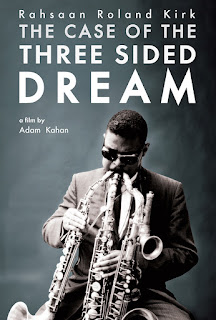The Case of the Three Sided Dream
Kirk played and collected many musical instruments, mainly multiple saxophones, clarinets and flutes. His primary saxophones were a standard tenor saxophone, stritch (a straight alto sax lacking the instrument's conventional upturned bell), and a manzello (a modified saxello soprano sax, with a larger, upturned bell). A number of his instruments were exotic or homemade. Kirk modified instruments himself to accommodate his simultaneous playing technique.[8] Critic Gary Giddins wrote that Kirk's tenor playing alone was enough to bring him "renown".[3]
Usually, he appeared on stage with all three horns hanging around his neck, and at times he would play a number of these horns at once, harmonizing with himself, or sustain a note for lengthy durations by using circular breathing. He used the multiple horns to play true chords, essentially functioning as a one-man saxophone section. Kirk insisted that he was only trying to emulate the sounds he heard in his head. Even while playing two or three saxophones at once, the music was intricate, powerful jazz with a strong feel for the blues.[3]
Kirk was also an influential flute player, including recorders. According to Giddins, Kirk was the first major jazz innovator on flute after Eric Dolphy (who died in 1964).[3] Kirk employed several techniques, including singing or humming into the flute at the same time as playing. Another was to play the standard transverse flute at the same time as a nose flute.
He played a variety of other instruments, including whistles; often kept a gong within reach; the clarinet, harmonica, English horn, and was a competent trumpeter.[9] He utilized unique approaches, such as playing a trumpet with a saxophone mouthpiece.
He also made use of non-musical devices, such as alarm clocks, sirens, or a section of common garden hose (dubbed "the black mystery pipes"). From the early 1970s, his studio recordings used tape-manipulated musique concrète and primitive electronic sounds before such things became commonplace.



Comments
Post a Comment